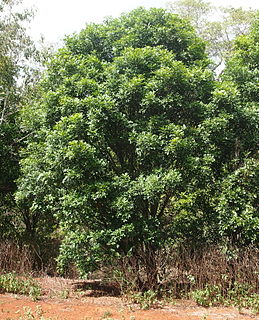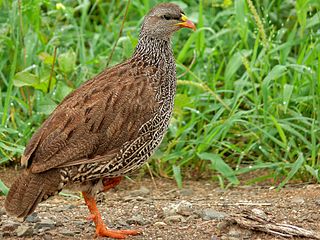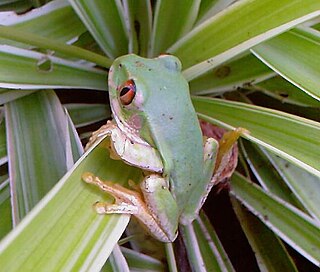
The red forest duiker, Natal duiker, or Natal red duiker is a small antelope found in central to southern Africa. It is one of 22 extant species form the subfamily Cephalophinae. While the red forest duiker is very similar to the common duiker, it is smaller in size and has a distinguishing reddish coloring. Additionally, the red forest duiker favors a denser bush habitat than the common duiker. The Natal red duiker is more diurnal and less secretive than most forest duikers, so therefore it is easier for them to be observed. In 1999, red forest duikers had an estimated wild population of 42,000 individuals.

Atalaya is a genus of eighteen species of trees and shrubs of the plant family Sapindaceae. As of 2013 fourteen species grow naturally in Australia and in neighbouring New Guinea only one endemic species is known to science. Three species are known growing naturally in southern Africa, including two species endemic to South Africa and one species in South Africa, Swaziland and Mozambique.

The Natal free-tailed bat is a species of bat in the family Molossidae, the free-tailed bats. It is endemic to the island of Mauritius. It is known from fewer than five locations in its range, but it is common at a few sites. It roosts in caves, and it is considered to be an endangered species due to disturbance of its cave habitat.

The Natal long-fingered bat is a species of vesper bat in the family Miniopteridae. It can be found in the following countries: Angola, Botswana, Democratic Republic of the Congo, possibly Ethiopia, Kenya, Lesotho, Malawi, Mozambique, Namibia, South Africa, South Sudan, Swaziland, Tanzania, Uganda, Zambia, and Zimbabwe. It is found in these habitats: dry savanna, moist savanna, Mediterranean-type shrubby vegetation, caves, and hot deserts. It is threatened by habitat loss.

The Natal multimammate mouse is a species of rodent in the family Muridae. It is also known as the Natal multimammate rat, the common African rat, or the African soft-furred mouse.
The tiny fat mouse is a species of rodent in the family Nesomyidae. It is found in Angola, Botswana, Ethiopia, Kenya, Mozambique, Namibia, South Sudan, Tanzania, Uganda, Zambia, and Zimbabwe. Its natural habitats are subtropical or tropical dry shrubland and subtropical or tropical dry lowland grassland.

The Natal spurfowl or Natal francolin is a species of bird in the family Phasianidae. It is found in Botswana, Eswatini, Mozambique, South Africa, Zambia, and Zimbabwe.

The Natal forest tree frog is a species of frog in the family Arthroleptidae, subfamily Leptopelinae, and is endemic to the eastern coastal area of South Africa. A typical tree frog, it has large eyes and a broad mouth. Its colouration is highly variable: Some may be bright green, others cream coloured, and some may be cream with olive-green blotches.

The Natal dwarf puddle frog is a species of frog in the family Phrynobatrachidae. It is found in Angola, Benin, Botswana, Burundi, Cameroon, Central African Republic, Republic of the Congo, Democratic Republic of the Congo, Ivory Coast, Eritrea, Ethiopia, Gambia, Ghana, Guinea, Guinea-Bissau, Kenya, Liberia, Malawi, Mali, Mozambique, Namibia, Nigeria, Rwanda, Senegal, Sierra Leone, South Africa, Sudan, Swaziland, Tanzania, Togo, Uganda, Zambia, Zimbabwe, and possibly Burkina Faso, Chad, Lesotho, and Mauritania.

The Natal sand frog is a species of frog in the family Pyxicephalidae. It is found in Mozambique, South Africa, and Swaziland, and possibly Botswana, Lesotho, and Zimbabwe. Its natural habitats are dry savanna, moist savanna, subtropical or tropical moist shrubland, temperate grassland, subtropical or tropical dry lowland grassland, subtropical or tropical high-altitude grassland, rivers, intermittent rivers, swamps, freshwater marshes, intermittent freshwater marshes, arable land, pastureland, and ponds.

The Natal ghost frog is a species of frog in the family Heleophrynidae. It is the only species in the genus Hadromophryne.

The red-capped robin-chat or Natal robin is a species of bird in the family Muscicapidae.

The Natal hinge-back tortoise, also known as Natal hinge-backed tortoise or Natal hinged tortoise, is a species of tortoise in the family Testudinidae which is restricted to eastern southern Africa to a relatively small area around the borders of Mozambique, South Africa, and Eswatini.

The Natal pygmy gecko is a species of South American lizard in the family Sphaerodactylidae.

The scaly yellowfish, or KwaZulu-Natal yellowfish, is a species of freshwater fish in the family Cyprinidae.

The Maputaland-Pondoland-Albany Hotspot (MPA) is a biodiversity hotspot, a biogeographic region with significant levels of biodiversity, in Southern Africa. It is situated near the south-eastern coast of Africa, occupying an area between the Great Escarpment and the Indian Ocean. The area is named after Maputaland, Pondoland and Albany. It stretches from the Albany Centre of Plant Endemism in the Eastern Cape Province of South Africa, through the Pondoland Centre of Plant Endemism and KwaZulu-Natal Province, the eastern side of Eswatini and into southern Mozambique and Mpumalanga. The Maputaland Centre of Plant Endemism is contained in northern KwaZulu-Natal and southern Mozambique.
Chrysoritis natalensis, the Natal opal, is a butterfly of the family Lycaenidae. It is found in South Africa, where it is found from the Eastern Cape, along the coast of KwaZulu-Natal and inland to Zululand and the midlands.
The natal wrasse, Anchichoerops natalensis, is a species of wrasse native to the Indian Ocean coasts of South Africa and Mozambique. It prefers areas with rocky substrates and can be found down to about 60 m (200 ft). This species grows to a length of 75 cm (30 in). This fish is of minor importance to local commercial fisheries and is popular as a game fish. This species is the only known member of its genus.

Encephalartos natalensis, the Natal cycad or giant cycad, is a species of cycad that is endemic to the Qumbu and Tabankulu areas of the northern part of the Eastern Cape, and through most of KwaZulu-Natal. The number of mature individuals of this species is declining and the International Union for Conservation of Nature has assessed its conservation status as being "near threatened".
















